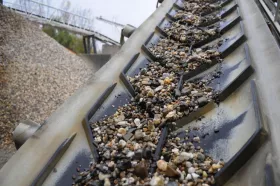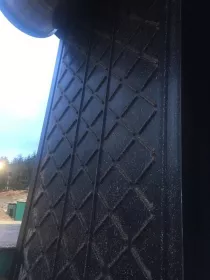
The actual amount of ‘extra’ rubber needed depends on the design and depth of the chevron pattern. The compression of the upper and lower plates then forces the additional rubber to flow into and fill the mould cavities. Vulcanisation of both the base belt structure and the rubber-filled moulds then takes place simultaneously to form a single homogenous unit.
Bearing in mind the technical complexity and the higher costs involved, perhaps it is not surprising that apart from Dunlop Conveyor Belting, hardly any other manufacturer of note produces profiled chevron belt in this way. However, the significantly superior strength, reliability and much longer working life that is created by chevron belting being made in this way makes it not only worth the effort but also worth the investment.
How will I know?

Even when armed with this understanding of the huge difference in strength and overall durability between chevron belts made using the conventional ‘two-step’ process and the ‘single homogenous structure‘, the dilemma then is how to establish which kind is being offered by the manufacturer/supplier who is providing the quotation. Unfortunately, the only way to find out is to ask the would-be supplier and then hope that the salesperson you are speaking to actually does know the difference!
Keeping a low Profile
‘High’ profile chevron belts are available in a variety of different heights, mostly 16mm, 25mm and 32mm. Some manufacturers only make the 25mm version. However, there are several belts on the market that have profile patterns that are little more than 5mm high and sometimes even less. Belting of this kind is mostly used for the transportation of packaged goods such as boxes, bags and baggage as well as bulk materials including agricultural products, oily materials, woodchips and wet sand and can successfully be used on inclines as steep as 30° in some cases.

Unlike their chevron counterparts, making single, homogenous structures is relatively easy to achieve with low profiles because the rubber only has to flow a small amount compared to high chevron profiles. Yet again, the key influencer as far as performance and value is concerned is the quality of the rubber. In this case it is ability of the rubber to resist wear (abrasion) and to resist the effects of ozone & ultra violet that are the most crucial. As far as European-based quality led manufacturers like Dunlop are concerned, achieving working lifetimes as long as five years is more than possible.
Don’t be fooled
When it comes to profiled belting, appearances can be very deceptive. One belt may look virtually identical to another belt and the basic specifications such as tensile strength and number of plies may also be identical. Therefore, expecting that the actual performance and working lifetime will be roughly the same would seem to be a reasonable assumption. However, the alarm bells should start to ring if there is a significant difference in the asking price. Actually, there is a very good reason why one belt can have a dramatically lower price compared to one of a seemingly identical specification, and that reason is very easy to explain. Ultimately, the difference in price will come down to the quality of the rubber, and it is the quality of the rubber that will have the biggest bearing on performance and the cost-effectiveness of the end product.




















